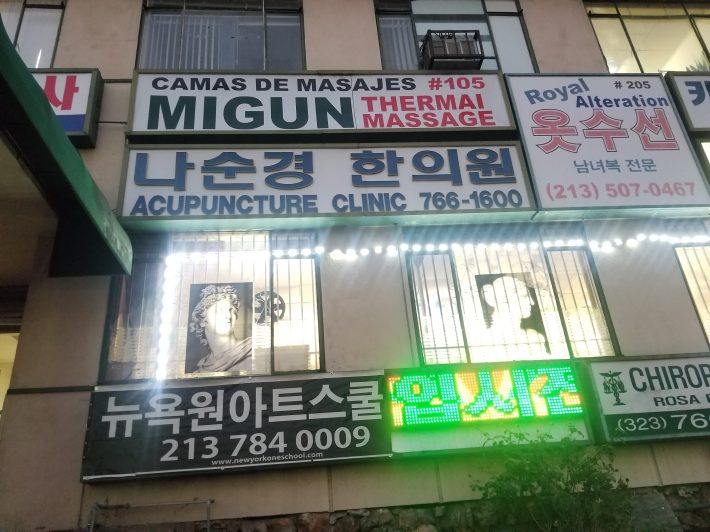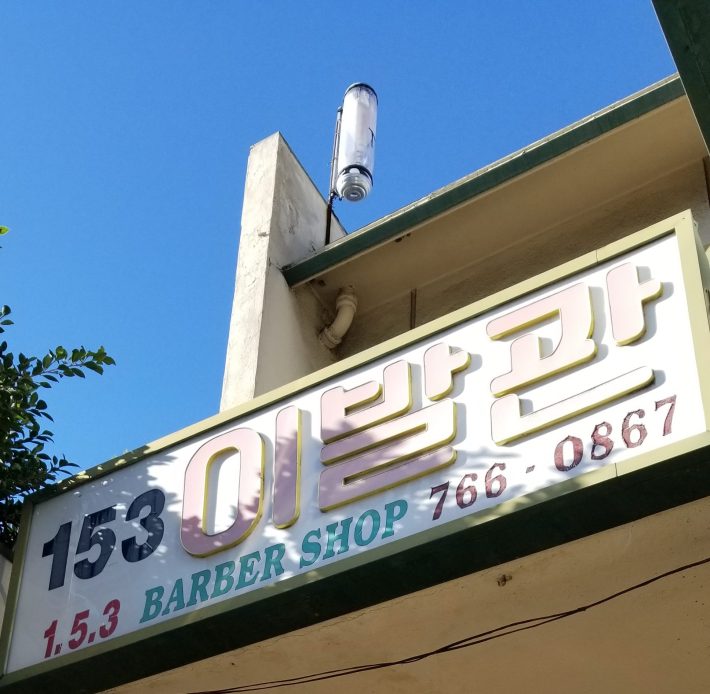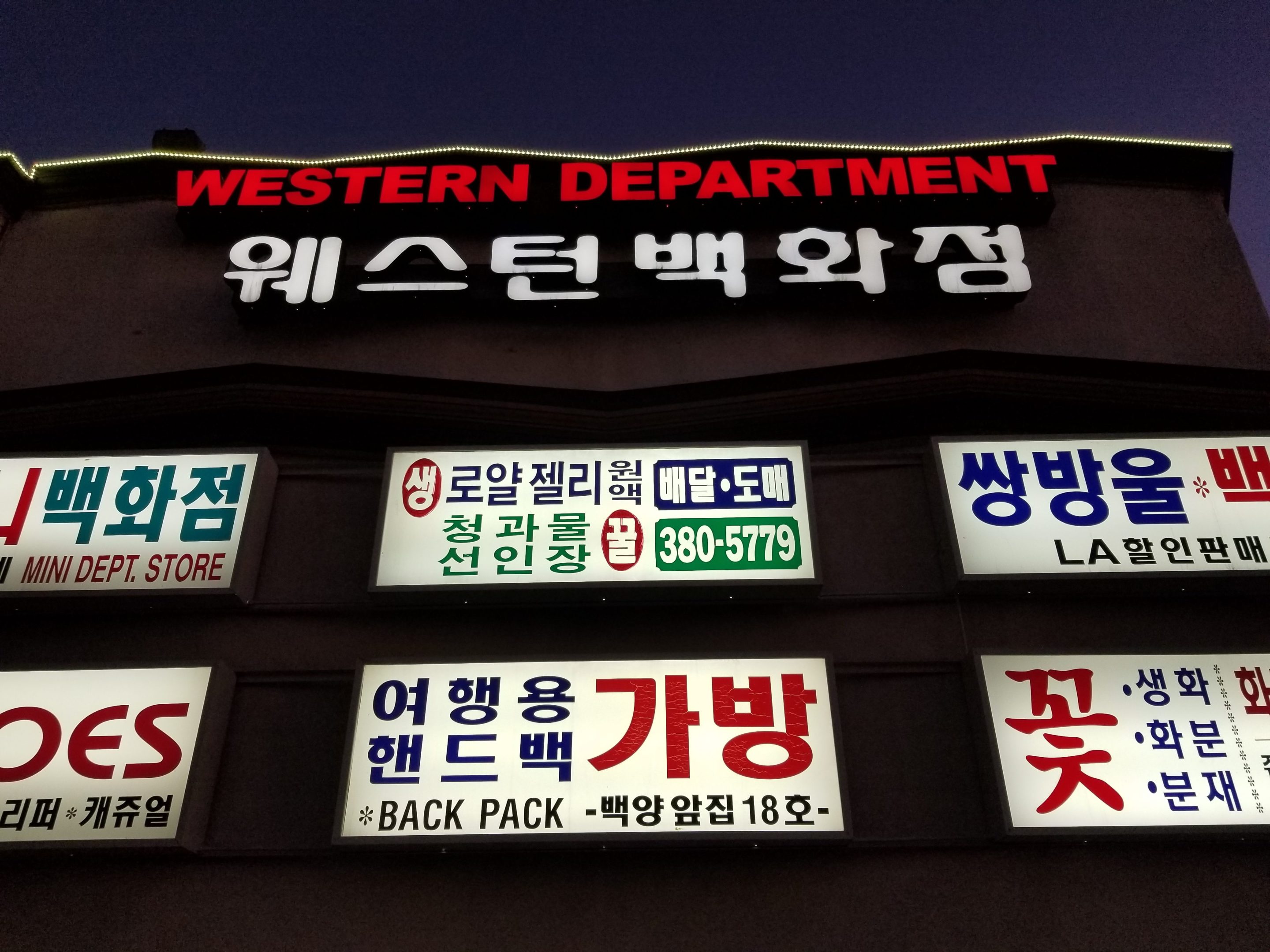[dropcap size=big]I[/dropcap]n Gap Chun, a barber, began 153 Barber Shop on Western Avenue in 1994. He is one of the first Korean immigrants to start a business on his particular block just north of Olympic Boulevard, a street that was instrumental in creating the boundaries of Koreatown.
Chun’s storefront is recognizable for its classic mesmeric barber’s pole attached to a text-heavy sign with sun-bleached block letters; it has not changed since he first opened shop 25 years ago. And this includes his lack of a prefix area code on his sign for the barbershop’s listed number. Many spots in Koreatown have never used a 213 — or the later imposed 323 — on their street-facing signage.
It’s a quirk in a lot of signs in Koreatown that I’ve noticed, and I’ve always wondered how this impacts the immigrant store owners who have set up shop here for years.

It turns out, a job well-done in Koreatown speaks far more convincingly than a sign could. Besides the obvious fact that most of the signage in Koreatown is in Korean, for most longtime residents, the mark of a good business is not about its outward appearance but rather the service behind its front doors. In fact, you could miss some of the best deals, sales, and expertise in town if you just relied on a phone, map, or sign.
For many store-owners such as Chun, the Koreatown attitude is to own its old-school 213-ness because quality is communicated. When 153 Barber Shop was issued its new 323 area code by the city, in 1998, Chun chose not to add the new area code to his already existing sign.
“The change didn’t affect my business anyways,” Chun said. “At this time, people in the city knew that my shop was in the new 323 zone, because local news was covering the new zones regularly to prepare the city.”
RELATED: Support Stories Like These and Become a Member Today!

The entire city of Los Angeles was assigned the 213 via the Bell System in 1947. It wasn’t until 1998 that the California Public Utilities Commission issued a split of the 213 to accommodate for the rapidly growing number of landlines in households. This move segmented Los Angeles’ neighborhoods on a more bureaucratic level. Specifically for the Koreatown area, all properties south of James M. Wood Boulevard were assigned 323.
Koreatown began piecing itself together in the 1970s and is now the epicenter ofthe largest number of Koreans in a single county in the United States. First- and second-wave immigrant families found a second home in Koreatown, although later, many families spread outward to suburban areas in Los Angeles and Orange counties. To this day, everyone knows what places to go to in Koreatown.
Chun didn’t add the area code to his signage after 2001 either when ten-digit dialing was mandated nationwide in order to place calls. “Today I’m one of the oldest barbers in Koreatown,” he affirmed.
“Many of my customers who have seen me the longest still live here, but there are plenty who have moved to other cities with Korean-Americans. They come back here,” he added. “People from all over the county come to me because I still use scissors.”

[dropcap size=big]W[/dropcap]estern Produce has been sitting inside a plaza on the northeast corner of Western and James M. Wood Boulevard since 1992, a time when all of Los Angeles was still 213. Its sign remains intact without the historic area code. Western Produce owner Tony Choi, with amusement, admits that he didn’t realize the area code was not listed on his sign.
“… But I haven’t had any problems with business,” Choi said. My customers have been the same. It’s the same folks who come here since I started.”
The immigrant-owned businesses who have been here the longest didn’t have the vernacular that most neighborhoods now have around design: homogenized font choices, Pantone colors of the year, and minimalism. Then look at how the older businesses in Koreatown have not subscribed to this shift. For several decades, they put up in lights the straight facts: the service they provide, the telephone number, and the address. While aesthetic choices are changing the rest of this city, a job well done in Koreatown speaks far more than a sign could.

Half-a-mile away from Western Produce, hair salon Sound of Scissors on Wilshire Boulevard has had its area code-less awning on display for 25 years. Same thing: No area code.
“[The sign] has been the same all this time. It doesn’t change the way we do business in here,” said Sara Kim, one of three owners of the salon.
Though these store signs chip and fade, they represent a business that is as reliable as a book with dog-eared pages and margin annotations. Perhaps it’s a testament to the lasting power of word-of-mouth; Korean businesses have worked hard enough not to hinge their success purely on “look and feel.”
There’s incredible sentimental value in continuing with the signs that gave many immigrants a start in Los Angeles. For shopkeepers like Chun at 153 Barber, keeping signage riddled with the same business information from the ‘90s feels like an exercise of choice.
“My sign has been up this way for so long that I just want to keep it,” Chun said. “It’s still my very first sign. I want to preserve that look.”







